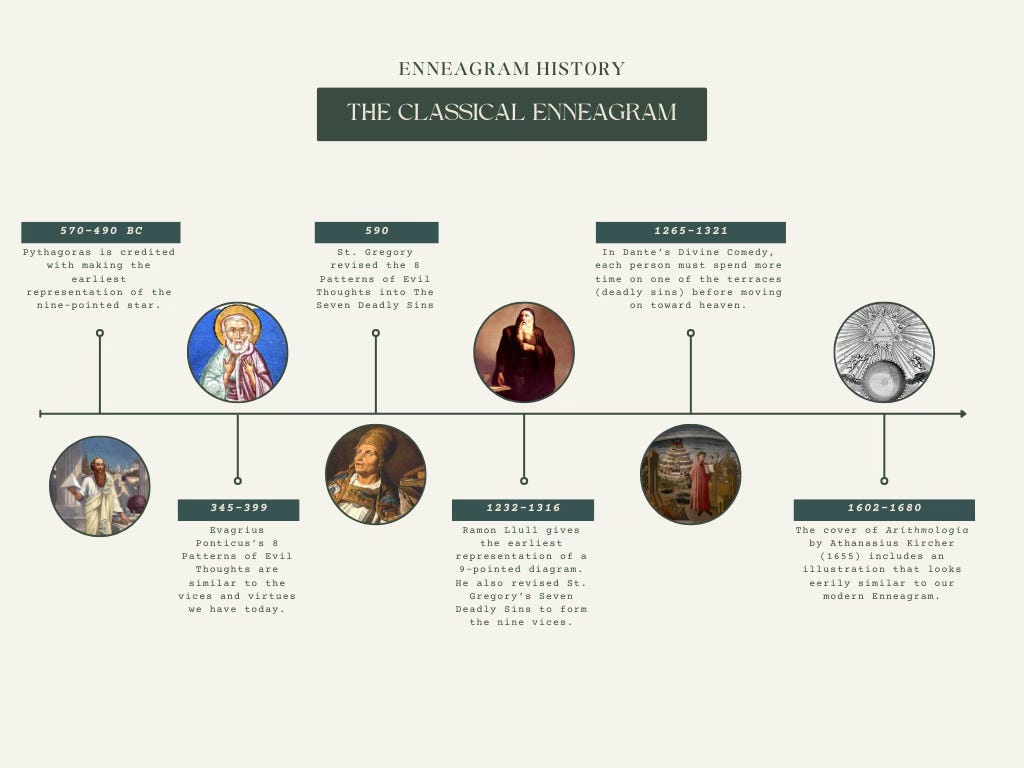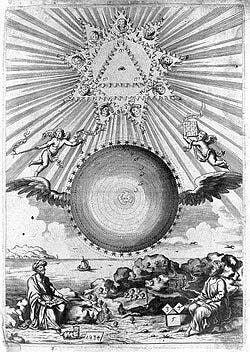A lot of people don’t realize that the Enneagram has a rich history. The history of the Enneagram can be categorized into two categories—The Classical and The Contemporary. The Classical history of the Enneagram begins roughly around 570 BC and ends roughly around 1680. (Beatrice Chestnut, Enneagram Teacher, suggests that there are connections between the Enneagram and Homer’s Odyssey which suggests that the history of the Enneagram begins earlier than 570 BC.) While the roots of the Classical Enneagram are a little shaky and indefinite, George Gurdjieff is credited as being the definite start of the Contemporary Enneagram in 1866.
The thing that I find the most interesting about the beginning of Enneagram history is that there was no intent to make a personality indicator—most of the early contributors were solely connect the spiritual to the mathematical. It wasn’t until Ramond Llull introduced the nine-pointed diagram (c. 1232–1316) that the Enneagram starts to emerge as defined system.
PYTHAGORUS (570–490 BC)
Although Beatrice Chestnut recognizes connections between the Enneagram and Homer’s Odyssey, Pythagorus is likely the best origin of the Enneagram’s formation. It was Pythagorus who created the math that led to the creation of the nine-pointed star which later became the symbol for the Enneagram.
Pythagorus believed that all truth is mathematical. And, unbeknownst to him, he believed in the Law of Three. The Law of Three is the belief that things come into being through a triadic pattern.
EVAGRIUS PONTICUS (345–399 BC)
Evagrius had a deep fascination with Pythagorus’s number theory—early Christians thought there were correlations between Biblical numbers and Pythagorus’s number theory.
I have divided this discourse on prayer into one hundred and fifty-three texts. In this way I send you an evangelical feast, so that you may delight in a symbolical number that combines triangular and hexagonal figure. The triangle indicates spiritual knowledge of the Trinity, the hexagon indicates the ordered creation of the world in six days…
— Evagrius Ponticus, Introduction to Chapter on Prayer
It was Ponticus who developed the Eight Patterns of Evil Thought, which are now known as the vices and virtues. Here’s a list of Ponticus’s Eight Patterns of Evil Thoughts [which were later] paired with each Enneagram type:
Gluttony and Abstinence (Type Seven).
Fornication and Chasity (Type Eight).
Avarice and Freedom from possessions (Type Five).
Sadness and Patience (Type Four).
Anger and Patience (Type One).
Acedia and Perseverance (Type Nine).
Vainglory and Freedom from vainglory (Type Three).
Pride and Humility (Type Two).
ST. GREGORY (590)
St. Gregory later revised Ponticus’s Eight Patterns to form the Seven Deadly Sins.
Lust (Type Eight).
Gluttony (Type Seven).
Sadness (Type Nine). (Later replaced with Sloth.)
Avarice (Type Five).
Anger (Type One).
Envy (Type Four)
Pride (Type Two).
RAMON LLULL (1232–1316)
Ramon Llull gives us the earliest visual representation of a nine-pointed diagram that can be found in history. Llull also developed the Nine Vices, which are now represented as Passions in the Enneagram.
Anger – ire (Type One).
Envy (Type Four).
Pride (Type Two).
Lust (Type Eight).
Avarice (Type Five).
Gluttony (Type Seven).
Sloth – acedia, accidie (Type Nine).
Lying – deceit (Type Three).
Inconstancy – faithlessness, lack of loyalty (Type Six).
DANTE ALIGHIERI (1265–1321)
It is believed that since both Dante and Llull were alive during the same time, Dante was aware of Llull’s work with the Seven Deadly Sins. And it’s from this awareness that Dante was inspired to write his famous Divine Comedy (1308–1320). The Divine Comedy is an allegorical representation of the soul’s journey towards God. And in this work, the Seven Deadly Sins can be found—each person must spend more time on one of the terraces (deadly sins) before moving on.
ATHANASIUS KIRCHNER (1602–1680)
The cover of Kirchner’s Magnum opus Arithmologia (1655) includes an illustration that looks very similar to the symbol for the modern Enneagram.
GEORGE GURDJIEFF (1866–1949)
Everything preceding George Gurdjieff holds loose relation to the Enneagram—it’s more theory than concrete evidence of the Enneagram’s history—Gurdjieff is where Enneagram history concretely begins.
Why does Enneagram concretely begin with Gurdjieff?
George Gurdjieff is credited with being the definite start of the Enneagram’s history because the exact symbol that is used for the Enneagram today made its first appearance through Gurdjieff and his students.
It was also Gurdjieff who gave the Enneagram more religious roots when he introduced the model as a spiritual symbol in the 1930s. Gurdjieff is directly attributed with developing the Enneagram diagram and the Centers of Intelligence (triads).
P.D. OUSPENSKY (1878–1947)
P.D. Ouspensky was a distinguished Russian student of Gurdjieff, and he wrote In Search of Miraculous: Fragments of an Unknown Teaching (a book about Gurdjieff’s beliefs). In his book, Ouspensky outlines Gurdjieff’s teachings into four core beliefs: waking up, three-brained beings, chief features, and the Enneagram symbol.
Arguably, had Ouspensky not written this book about Gurdjieff’s beliefs, then we may not know about the Enneagram. So, while Gurdjieff is the start of the modern Enneagram, thanks is due to Ouspenksy for making Gurdjieff’s work publicly known.
ST. IGNATIUS (1491–1556)
The last contribution toward the Classical Enneagram comes from St. Ignatius.
By teaching us to awaken our soul to the Spirit’s movement in our head, heart, and gut, St. Ignatius inspired the creation of the Harmony Triads (the Harmony Triads show how each Enneagram type relates to the world) of the Enneagram.
Now, that you have learned about the history of the Classical Enneagram, you might have also gained a better sense of understanding of why I—along with Suzanne Stabile and many others—believe that the “trendy” Enneagram is doing more harm than good. I can almost guarantee that by the time you finish learning the history of the Modern Enneagram you will join us in this believe… you will see the value of the Enneagram beyond what you see on Instagram and other social media.
And that value is something that is truly transformational.
Primary Source: Tyler Zach, The Real History of the Enneagram online course.




